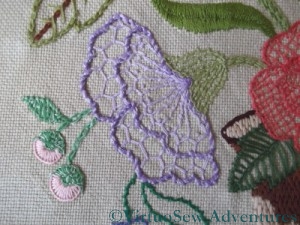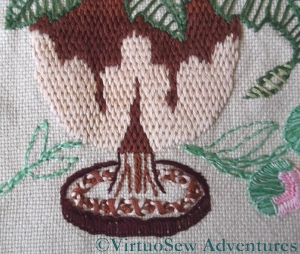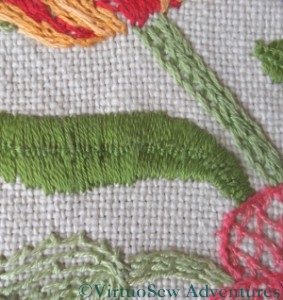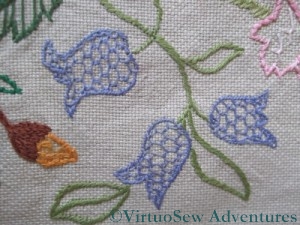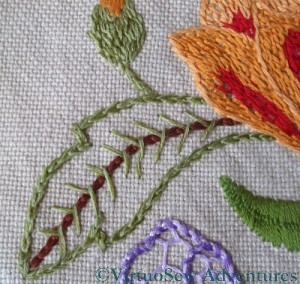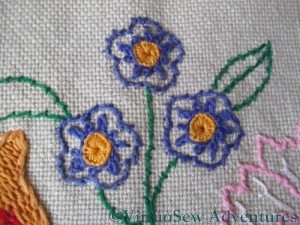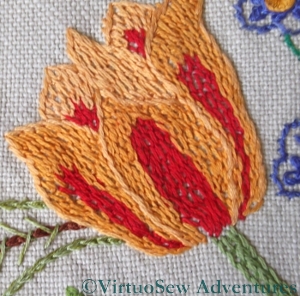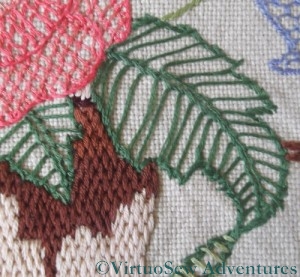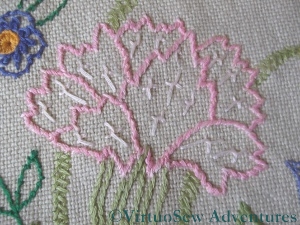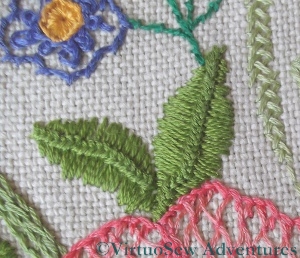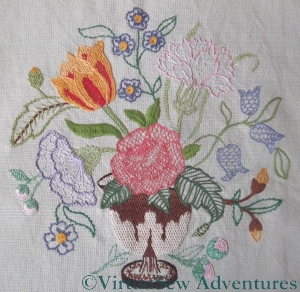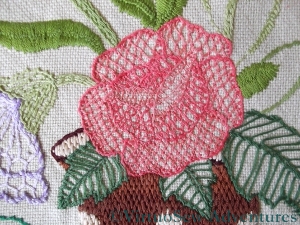Tag: first voluntary project
First Voluntary Project – Fifth Installment
This chrysanthemum is outlined, like the other, in Whipped Stem Stitch, but in this case the filling is Cretan Stitch, quite widely spaced. I rather like the slightly rippling effect this creates, but the stitches perhaps needed to be just a little more closely packed to make the ripple a bit stronger. The calyx is rows of coral stitch, and the stems of those strange little buds are the very first appearance in my work of one of my favourite stitches – Cable Chain Stitch.
The vase is worked in Brick Stitch, and since the fabric is a heavy square weave it was easy to do as a counted stitch – easier than when I worked the Prince’s Steed in the Persian Fantasy!
The foot of the vase is in closely-packed blanket stitch, and the ornamentation is Whipped Chain Stitch. I think if I were to be working it like this now, I would continue the brick stitch down the stem of the vase and leave out the whipped chain. But after all, it was my first solo project…
Naturally this won’t be going on display anywhere, but it’s been fascinating to revisit it, and try to remember what I chose and why. There wasn’t much of the why, but I’ve enjoyed looking at my experiments, anyway!
First Voluntary Project – Fourth Installment
This long leaf is worked in Bokhara Couching. I find it strange that it did not occur to me at the time that this stitch is as near to satin stitch as makes very little difference! It isn’t particularly neat, in fact it is even rather crammed together, but it serves a purpose, and the stitch is a useful one to know.
I’ve seen diagrams that refer to this as “Roumanian couching” and “Romanian Stitch” , as well as Bokhara couching, which can make life confusing at times.
I’m now using it on the Finnish Embroidery, stitched in pearl cotton – it creates a lovely “basketlike” texture.
The bluebells are outlined in stem stitch and then filled with Cretan stitch, carefully spaced to create a sort of honeycomb effect. I rather like this, and I’m sad to say that I’ve not used it very much since. It’s good to be reminded of it, and I will try to use it again! The stems are worked in stem stitch, although angled to create a much thicker line than is normal – another effect I rather like, but rarely use.
The golden yellow bud is filled with Ceylon Stitch, which I found myself using in the Goldwork Masterclass, while the calyx is chain stitch again. The Ceylon stitch is the only one which has suffered from the passage of time, but since it was worked in a single strand, that’s scarcely surprising!
First Voluntary Project – Third Installment
Since I was working with leftover threads from other people’s projects, I was “forced to become inventive” – as Joseph Haydn said in another context!
The leaf and bud shown here use Chain Stitch, but I combined single strands of two or three colours in the needle. This is a technique that I don’t necessarily use very often, but it is always one I consider, because heathering is such a good way to create subtle variations in colour and tone. There’s a nice example of this on The Floss Box blog, where the thread for the water is blended in the needle.
The veins are marked in Thorn Stitch, although I’ve just noticed that the central vein is in Chain Stitch!
The forget-me-knots and attached leaves and stems are almost a sampler all by themselves. The leaves and stems are worked in Coral Stitch, which also outlines the flowers. Inside the flowers, there are tiny circles of Rosette Chain Stitches, worked around a Buttonhole Wheel in golden yellow. Rosette chain looks better worked rather bigger than this – I’ve used it since in several projects – and those who followed my posts on the Goldwork Masterclass will know by now that I have since developed a positive obsession with stitch and fabric scale!
The Tulip is filled with close rows of Feather Stitch in red and golden yellow, outlined with stem stitch. It creates a slightly odd texture that I’m not entirely unhappy with, although it would balance the other flowers better if the filling were not so closely packed, and the colours were rather paler.
The stem is worked in a single row of chain stitch with a row of stem stitch on each side. I was gaining enough of a grip on embroidery by this stage that I made an effort to keep the stitch lengths comparable, which gives a nice regular rhythm to the stem.
First Voluntary Project – Second Installment
The leaves that went with the Rose were worked in Blanket Stitch, set back to back down the central vein of the leaf, and outlined in Stem Stitch. In fact, if you look closely at the photo it seems that I worked the outline first and then the blanket stitch, stitching right over the outline. The leaf is really rather too large and the stitches ended up a little floppy. I think that now I would work the blanket stitch more closely, but keep it shorter, leaving unstitched fabric between it and the outline.
I’m calling this a chrysanthemum, but heaven knows what it was intended to be! The outline is in Whipped Stem Stitch, using two different, but very close shades of pink. The petals contain scatters of Sword Stitches. I think I would now make the sword stitches much smaller, if I were going to use them, and maybe vary the colours as well. The long skinny leaves that run behind the flower are worked in Closed Herringbone Stitch – strange to see that one popping up when I’ve used it so much in reverse on the Map of Amarna! The calyx is worked using several rows of stem stitch – I’d work these much more closely now, and maybe even use two different colours.
I’ve used Vandyke Stitch for leaves on other occasions as well. It creates a slightly unnatural leaf, because the central vein is raised rather than indented, but it creates a variety of texture that can be very useful.
It can be a slightly tricky stitch to get right, since if the tension is wrong (and it goes wrong very easily!) the central braided spine becomes decidedly wriggly. It’s easier in a round yarn rather than a stranded one, so as I look at these two leaves, I’m really quite impressed with Teenage Me!
First Voluntary Project – First Installment
For all that I have shown you a variety of pieces of needlework from when I was Very Young, this atrocious farrago, worked in my mid-teens, is actually the real start of my embroidery career. I found the transfer and fabric in a suitcase of cloth one afternoon when I was looking for something to do as a change from schoolwork. My other hobbies – playing in orchestras, singing in choirs, and dancing lessons – all involved my parents in ferrying me around, and I wanted something I could just pick up and put down again. I doubt that any of us had any idea what was about to begin!
It gives very clear evidence that skill in stitching and in colour don’t always come naturally – although in fairness to myself, I simply pulled threads from my Grandmama’s stash, because I wasn’t yet sure enough that I enjoyed embroidery to spend money on it!
I remember that I’d already discovered (I can’t remember how!) that Long and Short Stitch, and Satin Stitch, while simple in concept, are utterly infuriating to stitch, especially if you are learning from a book, so there’s not a scrap of either stitch in the whole thing. I had a great time leafing through Barbara Snook’s “Embroidery Stitches“, which Grandmama had given my mother, and picking stitches to try.
I started bang in the middle with the Rose, outlined in blanket stitch and with the petals filled in with Jacobean Couching. At the combination of scale of the petals and the stitch it looks much too busy, as it turns out, and it would have looked better if I had outlined the petals in a much darker colour to help differentiate them. Lesson learned!
I will write more about this, because although the thing as a whole is rather horrifying, as I look at it I think some of the stitch choices are interesting, but sometimes not quite taken far enough. Besides, it’s extremely gratifying to see that my work has improved very considerably!

